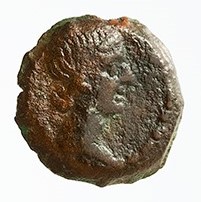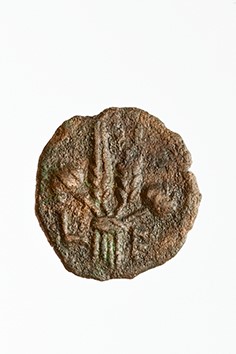Title: Obol of Tiberius - 1967.20
Acquisition number: 1967.20
Author or editor: Beryl Rawson
Culture or period: Roman Imperial
Date: AD 17-18
Material: Metal - Bronze
Object type: Coins - Roman
Dimensions: 15mm (w)
Origin region or location: Egypt
Origin city: Alexandria
Display case or on loan: 5
Keywords: Coin, obol, Roman, Imperial, Livia, Tiberius, Roman Egypt, Alexandria
Burnett, A., Roman Provincial Coinage (London, British Museum Press, 1992) I 5086 (Alexandria); Poole, R.S., (ed.), A Catalogue of the Greek Coins in the British Museum (London, The British Museum, 1873-1927; repr. Bologna 1963-1964)Alexandria and the Nomes no. 62.
1967.20
Obol of Tiberius
2.164 g. AD 17-18
Obv.: Head of Livia r., hair tied in knot at nape of neck.
Rev.: Sheaf of grain-ears and poppy-heads tied together. 'LE (interlocked)'
Minted in Alexandria. After Augustus made Egypt a province, he issued bronze coins similar to those of Cleopatra. Tiberius also issued some bronze (e.g. this obol), but began the series of billon (copper-silver) tetradrachms which were issued from Alexandria by succeeding Roman emperors.
The inscription on the reverse signifies ‘the fifth year’ (of Tiberius’ reign), i.e. (on the Alexandrian system of dating) between August of AD 17 and August of AD 18.
Livia’s head had appeared on Alexandrian coins (but not Roman ones) in Augustus’ lifetime, and this is a continuation of the same type. Grain-ears and poppy-heads are often associated with Demeter (Greek goddess of crops, especially grain). They symbolise the important agricultural products of Egypt.
Burnett, A., Roman Provincial Coinage (London, British Museum Press, 1992) I 5086 (Alexandria); Poole, R.S., (ed.), A Catalogue of the Greek Coins in the British Museum (London, The British Museum, 1873-1927; repr. Bologna 1963-1964)Alexandria and the Nomes no. 62.

